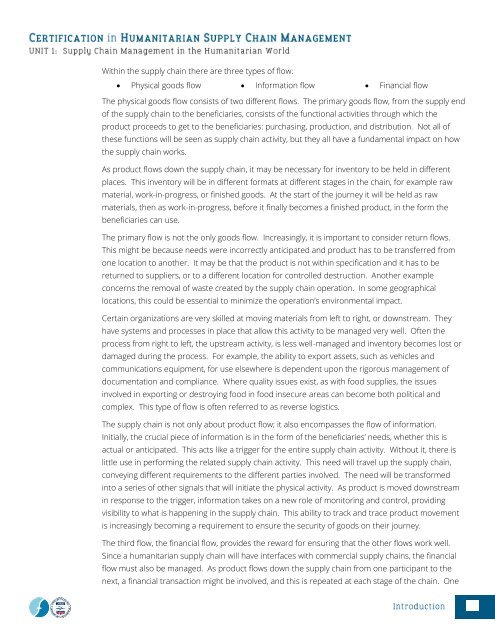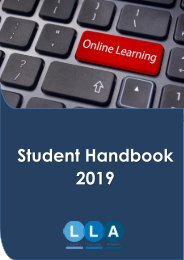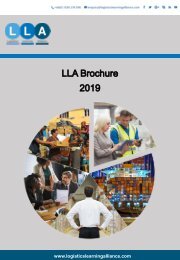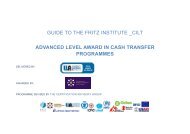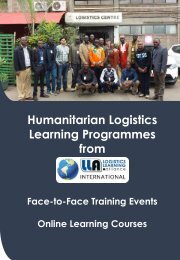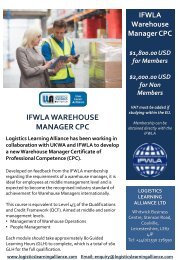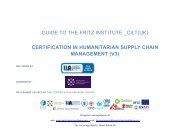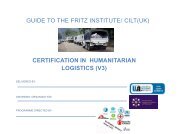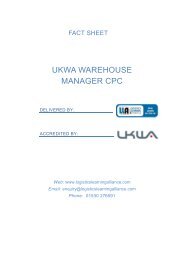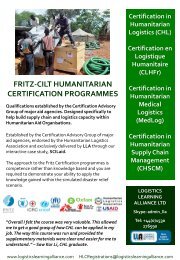CHSCM 3.0 - Unit 1 - SCM in the Humanitarian World
Learning Materials for Unit 1 of the Certification in Humanitarian Supply Chain Management (CHSCM).
Learning Materials for Unit 1 of the Certification in Humanitarian Supply Chain Management (CHSCM).
Create successful ePaper yourself
Turn your PDF publications into a flip-book with our unique Google optimized e-Paper software.
With<strong>in</strong> <strong>the</strong> supply cha<strong>in</strong> <strong>the</strong>re are three types of flow:<br />
• Physical goods flow • Information flow • F<strong>in</strong>ancial flow<br />
The physical goods flow consists of two different flows. The primary goods flow, from <strong>the</strong> supply end<br />
of <strong>the</strong> supply cha<strong>in</strong> to <strong>the</strong> beneficiaries, consists of <strong>the</strong> functional activities through which <strong>the</strong><br />
product proceeds to get to <strong>the</strong> beneficiaries: purchas<strong>in</strong>g, production, and distribution. Not all of<br />
<strong>the</strong>se functions will be seen as supply cha<strong>in</strong> activity, but <strong>the</strong>y all have a fundamental impact on how<br />
<strong>the</strong> supply cha<strong>in</strong> works.<br />
As product flows down <strong>the</strong> supply cha<strong>in</strong>, it may be necessary for <strong>in</strong>ventory to be held <strong>in</strong> different<br />
places. This <strong>in</strong>ventory will be <strong>in</strong> different formats at different stages <strong>in</strong> <strong>the</strong> cha<strong>in</strong>, for example raw<br />
material, work-<strong>in</strong>-progress, or f<strong>in</strong>ished goods. At <strong>the</strong> start of <strong>the</strong> journey it will be held as raw<br />
materials, <strong>the</strong>n as work-<strong>in</strong>-progress, before it f<strong>in</strong>ally becomes a f<strong>in</strong>ished product, <strong>in</strong> <strong>the</strong> form <strong>the</strong><br />
beneficiaries can use.<br />
The primary flow is not <strong>the</strong> only goods flow. Increas<strong>in</strong>gly, it is important to consider return flows.<br />
This might be because needs were <strong>in</strong>correctly anticipated and product has to be transferred from<br />
one location to ano<strong>the</strong>r. It may be that <strong>the</strong> product is not with<strong>in</strong> specification and it has to be<br />
returned to suppliers, or to a different location for controlled destruction. Ano<strong>the</strong>r example<br />
concerns <strong>the</strong> removal of waste created by <strong>the</strong> supply cha<strong>in</strong> operation. In some geographical<br />
locations, this could be essential to m<strong>in</strong>imize <strong>the</strong> operation’s environmental impact.<br />
Certa<strong>in</strong> organizations are very skilled at mov<strong>in</strong>g materials from left to right, or downstream. They<br />
have systems and processes <strong>in</strong> place that allow this activity to be managed very well. Often <strong>the</strong><br />
process from right to left, <strong>the</strong> upstream activity, is less well-managed and <strong>in</strong>ventory becomes lost or<br />
damaged dur<strong>in</strong>g <strong>the</strong> process. For example, <strong>the</strong> ability to export assets, such as vehicles and<br />
communications equipment, for use elsewhere is dependent upon <strong>the</strong> rigorous management of<br />
documentation and compliance. Where quality issues exist, as with food supplies, <strong>the</strong> issues<br />
<strong>in</strong>volved <strong>in</strong> export<strong>in</strong>g or destroy<strong>in</strong>g food <strong>in</strong> food <strong>in</strong>secure areas can become both political and<br />
complex. This type of flow is often referred to as reverse logistics.<br />
The supply cha<strong>in</strong> is not only about product flow; it also encompasses <strong>the</strong> flow of <strong>in</strong>formation.<br />
Initially, <strong>the</strong> crucial piece of <strong>in</strong>formation is <strong>in</strong> <strong>the</strong> form of <strong>the</strong> beneficiaries’ needs, whe<strong>the</strong>r this is<br />
actual or anticipated. This acts like a trigger for <strong>the</strong> entire supply cha<strong>in</strong> activity. Without it, <strong>the</strong>re is<br />
little use <strong>in</strong> perform<strong>in</strong>g <strong>the</strong> related supply cha<strong>in</strong> activity. This need will travel up <strong>the</strong> supply cha<strong>in</strong>,<br />
convey<strong>in</strong>g different requirements to <strong>the</strong> different parties <strong>in</strong>volved. The need will be transformed<br />
<strong>in</strong>to a series of o<strong>the</strong>r signals that will <strong>in</strong>itiate <strong>the</strong> physical activity. As product is moved downstream<br />
<strong>in</strong> response to <strong>the</strong> trigger, <strong>in</strong>formation takes on a new role of monitor<strong>in</strong>g and control, provid<strong>in</strong>g<br />
visibility to what is happen<strong>in</strong>g <strong>in</strong> <strong>the</strong> supply cha<strong>in</strong>. This ability to track and trace product movement<br />
is <strong>in</strong>creas<strong>in</strong>gly becom<strong>in</strong>g a requirement to ensure <strong>the</strong> security of goods on <strong>the</strong>ir journey.<br />
The third flow, <strong>the</strong> f<strong>in</strong>ancial flow, provides <strong>the</strong> reward for ensur<strong>in</strong>g that <strong>the</strong> o<strong>the</strong>r flows work well.<br />
S<strong>in</strong>ce a humanitarian supply cha<strong>in</strong> will have <strong>in</strong>terfaces with commercial supply cha<strong>in</strong>s, <strong>the</strong> f<strong>in</strong>ancial<br />
flow must also be managed. As product flows down <strong>the</strong> supply cha<strong>in</strong> from one participant to <strong>the</strong><br />
next, a f<strong>in</strong>ancial transaction might be <strong>in</strong>volved, and this is repeated at each stage of <strong>the</strong> cha<strong>in</strong>. One


